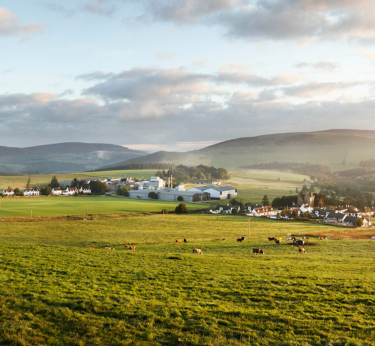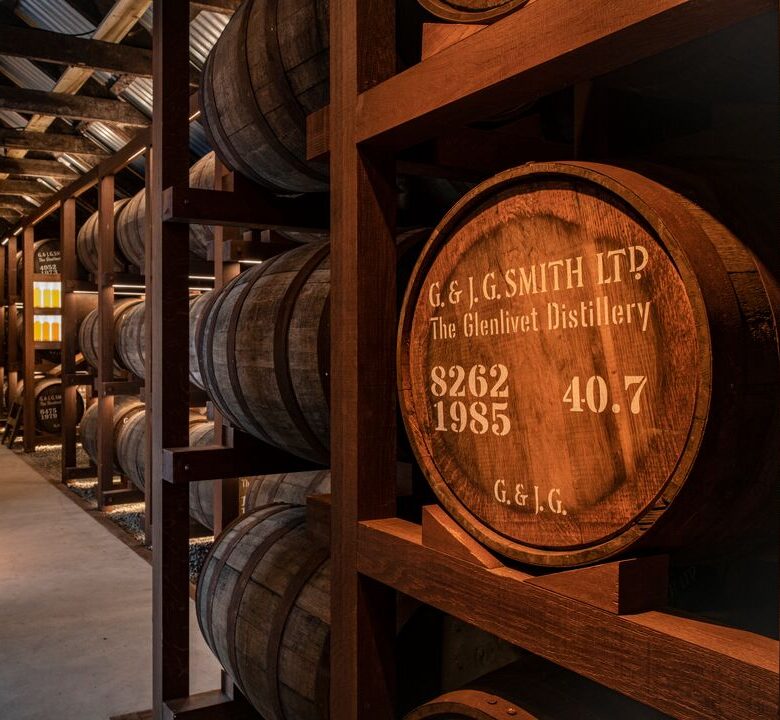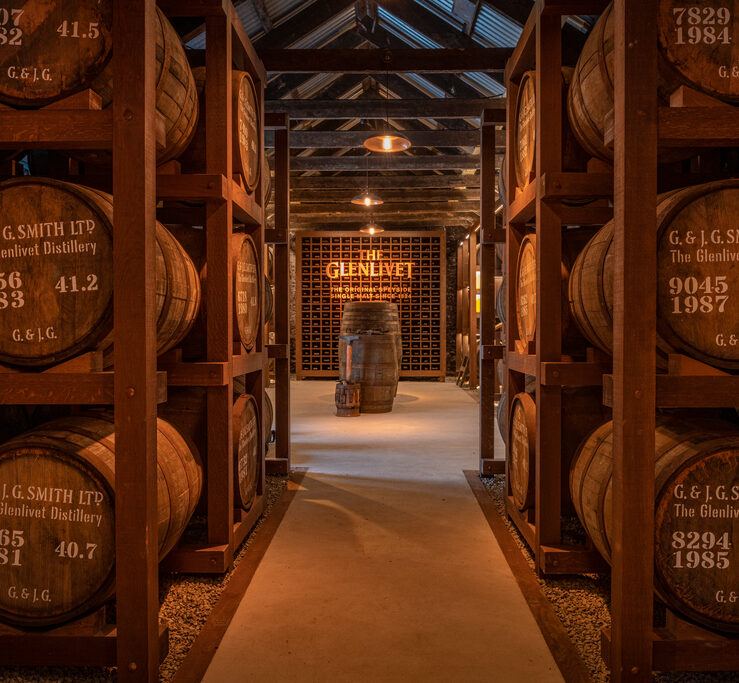
Ageing whisky is an art as much as it is a science. From the carefully selected grains to the distillation process, every step plays a crucial role in shaping the final flavour profile of this spirit. However, perhaps one of the most influential factors in the whisky ageing journey is the whisky maturation process.
It is the time that the spirit spends in the cask where the magic really happens. The wood of the cask shares itself with the whisky, imparting flavour, colour, and aroma while also removing undesirable traits from the liquid. But what type of cask is used? Well, that depends on the desired profile of the final product.
Let’s delve into the topic of cask selection when ageing whisky, defining what a cask is, exploring the factors that influence cask selection, and demystifying terms such as select cask, cask number, and cask strength.
What does cask mean in Scotch maturation?
Simply put, a cask is a barrel or container used for ageing and storing whisky. Traditionally made from oak, casks serve as vessels where the whisky undergoes its transformative maturation journey, gaining complexity and character from the wood and previous contents of the cask. Ergo, cask selection for ageing whisky is the process of a distillery choosing the perfect cask to mature each of their whisky types in.
What factors influence cask selection when ageing whisky?
When it comes to crafting exceptional whisky, every detail matters, so choosing the right whisky cask is paramount. This is because the type and history of the cask influence the characteristics of the whisky, including its flavour and colour.
There are several different aspects that a whisky producer must carefully consider when selecting a cask for maturation:
Oak origin
Oak casks are typically used for maturing whisky. This is because the wood is strong and durable, ensuring that the whisky won’t leak out of the cask, but it is also porous enough to allow the whisky to absorb naturally occurring oils and compounds from it.
The type of oak used in crafting the cask significantly impacts the whisky’s flavour profile and there are three main types of oak used in whisky casks: American oak, European oak, and Japanese (Mizunara) oak.
American oak
Renowned for its prevalence in bourbon ageing, American white oak (Quercus alba) is a popular choice among whisky distillers worldwide. The porous nature of American oak allows for significant interaction between the whisky and the wood, resulting in rich, complex flavours.
American oak imparts prominent notes of vanilla, caramel, and butterscotch to the whisky, courtesy of the wood’s high levels of vanillin and lactones. These sweet, creamy flavours are complemented by hints of coconut and toasted oak, contributing to a smooth and approachable taste profile.
European oak
In contrast to American oak, European oak (Quercus robur or Quercus petraea) offers a more nuanced and spicy character to whisky. Commonly used in sherry and wine ageing, European oak casks bring forth multifaceted flavours and aromas.
Whiskies aged in European oak are characterised by notes of dried fruits, baking spices, and dark chocolate, courtesy of the wood’s higher tannin content and presence of compounds such as ellagitannins. These flavours are often more robust and intense compared to those derived from American oak, adding depth and intrigue to the final product.
Japanese oak
Native to Japan, Mizunara oak (Quercus mongolica) is prized for its rarity and distinctive flavour profile. Mizunara oak imparts delicate notes of sandalwood, incense, and spices such as cinnamon and clove to the whisky. Its porous nature allows for rapid maturation, resulting in whiskies with a pronounced oak influence and a harmonious balance of flavours. Moreover, Mizunara oak is known for its high moisture content, which contributes to a silky-smooth mouthfeel and a lingering finish that evolves gracefully over time.
Charring and toasting
The level of charring or toasting applied to the cask interior plays a vital role in whisky maturation. All whisky casks are toasted but not all of them are charred. Toasting caramelises the natural sugars in the wood, introducing notes including vanilla, toffee, and spice into the whisky.
Charring, on the other hand, opens up the wood, making it easier for the spirit to penetrate the wood and extract flavour. The cracks produced in the wood by charring also increase the surface area available to the whisky. In addition, the charcoal layer created by charring the cask acts as a filtration system, removing unpleasant components, such as sulphur, from the liquid.
Size of the cask
The size of the cask determines the whisky’s interaction with the wood. Smaller casks offer a greater surface area-to-volume ratio, accelerating maturation and intensifying flavours, whereas larger casks allow for slower, more nuanced ageing. Whisky casks, from smallest to largest, include:
- Blood-tub: 30-40 litres
- Octave: 50 litres
- Quarter cask: 125 litres
- American standard barrel: 200 litres
- Standard barrel/Hogshead: 230-250 litres
- Port Pipes: 350+ litres
- Butt: 500 litres
- Puncheon: 500-700 litres
Previous liquids
Many whisky casks have previously held other spirits such as bourbon, rum, or sherry. These residual flavours left behind in the wood can influence the whisky’s taste profile, adding layers of complexity and depth.
Bourbon casks
Bourbon casks are among the most used casks for ageing whisky. Made from American white oak, these casks impart distinct flavours of vanilla, caramel, and butterscotch to the whisky from the charred wood which can be experienced with The Glenlivet 22 Year Old whisky. Moreover, the previous bourbon contents leave behind subtle hints of corn sweetness and oak spice, contributing to a smooth and well-rounded character in the aged whisky.
Rum casks
Casks previously used for ageing rum infuse whisky with a tropical flavour profile. They introduce notes of tropical fruits such as pineapple, banana, and mango. The rich and sweet characteristics of rum, along with its molasses undertones, lend a luscious and indulgent quality to the whisky, resulting in a harmonious blend of Caribbean influence and traditional whisky depth. The Glenlivet Caribbean Reserve is a perfect example of how ex-rum casks can help add a delightful twist.
Sherry casks
Whiskies aged in sherry casks develop notes of dried fruits, such as raisins, figs, and dates, along with nuances of nuts, spices, and dark chocolate. The residual sherry in the wood infuses the whisky with a velvety sweetness and a luscious mouthfeel, while the oak tannins contribute to a lingering, dry finish. Sherry casks are revered for their transformative effect on whisky, producing robust and full-bodied expressions like The Glenlivet 10 Year Old Single Cask Sherry Butt.
Number of fills
As casks are often reused for multiple batches of whisky, each subsequent fill extracts fewer flavours from the wood. However, this isn’t necessarily a bad thing. The number of fills impacts the depth of flavour and intensity of the final product, with first-fill casks typically producing more robust whiskies.
But second-fill or third-fill whiskies gain their flavour from the cask more slowly, meaning that with careful monitoring, a whisky producer can adjust the maturation over years, resulting in a meticulously crafted expression.
What does select cask mean?
The term “select cask” refers to a cask that has been handpicked by master distillers or blenders for its exceptional quality and unique characteristics. These casks often produce limited-edition whiskies prized for their distinctive flavour profiles and rarity.
What does cask number mean?
The cask number denotes the specific identification assigned to each individual cask during the ageing process. This numbering system allows distilleries to track the history and maturation progress of each cask, ensuring consistency and quality control.
What does cask strength mean?
Cask strength whisky is bottled directly from the cask without dilution, resulting in a higher alcohol by volume (ABV) compared to standard releases. This unadulterated expression showcases the whisky in its purest form, allowing enthusiasts to experience its full intensity and complexity.
Cask selection is a nuanced and critical aspect of whisky production, influencing its flavour, aroma, and overall character. By understanding the various factors at play, whisky enthusiasts can appreciate the artistry behind their favourite drams and gain deeper insights into the world of aged spirits.
If you want to learn more about the intricacies of whisky production, take a look at our guides that explain how scotch is made and what whisky is made from. Or unearth interesting insights with our whisky facts and explanation of angel’s share whisky.



